
The Natural Wonders of the Westfjords of Iceland - Látrabjarg and Rauðasandur

While spending 9 days in the Westfjords on my summer vacations I joined Westfjords Adventures on a guided tour of two of the main attractions in the Westfjords: Látrabjarg bird-cliff and Rauðasandur the Red Sand.
Westfjords Adventures is the only travel operator in the southern part of the Westfjords - offering a very good selection of tours to some pretty amazing sights in the Westfjords of Iceland. They are located in Patreksfjörður village, the biggest village in the southern part of the Westfjord Region.
Top photo: a puffin at Látrabjarg Westfjord
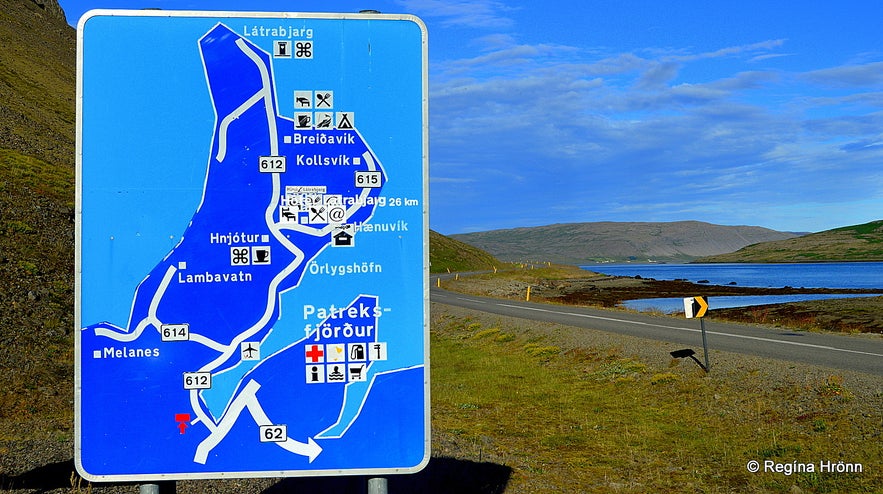
Road signs leading to Látrabjarg and Rauðasandur
This was our second day in the Westfjords and we were driving all the way from Reykjavík, so we spent the night with relatives on Barðaströnd. Early next morning we met up with Westfjord Adventures on the parking lot by the junction leading to Látrabjarg bird cliff.
We picked up more passengers on the way and off we went to visit one of the largest seabird cliffs in Europe - the cliff of all cliffs in Iceland.
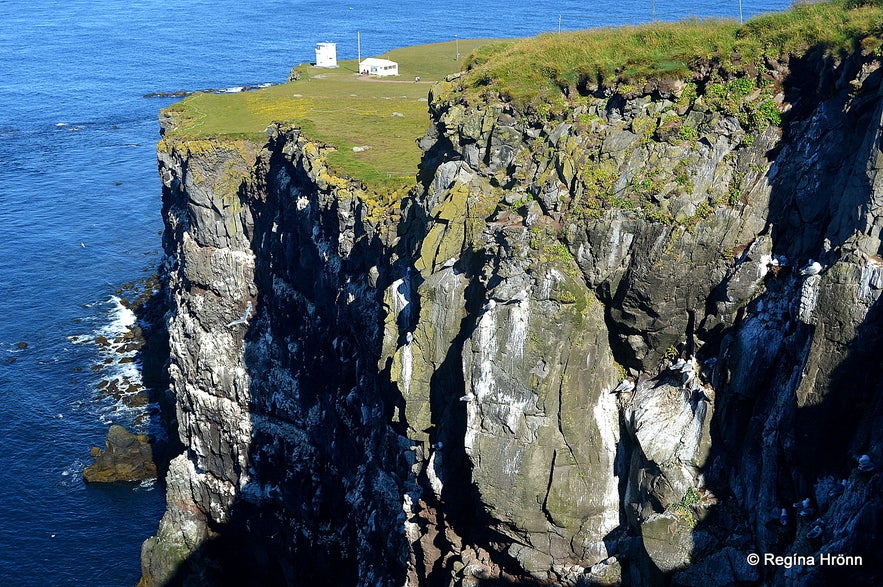
Látrabjarg - Bjargtangi
Látrabjarg bird cliff is the westernmost part of Iceland and one of the westernmost parts of Europe (24°32'´3" west). It is often called the westernmost point of Europe if you skip the mid-Atlantic archipelago of the Azores.
Látrabjarg is over 440 meters high and 14 km long and here you will find millions of sea birds.
Látrabjarg is considered to be one of the most spectacular seabird cliffs in the world and the birdlife here is really amazing. You will see razorbills, guillemot, the northern gannet, and puffins in abundance - amongst many, many more sea-bird species.
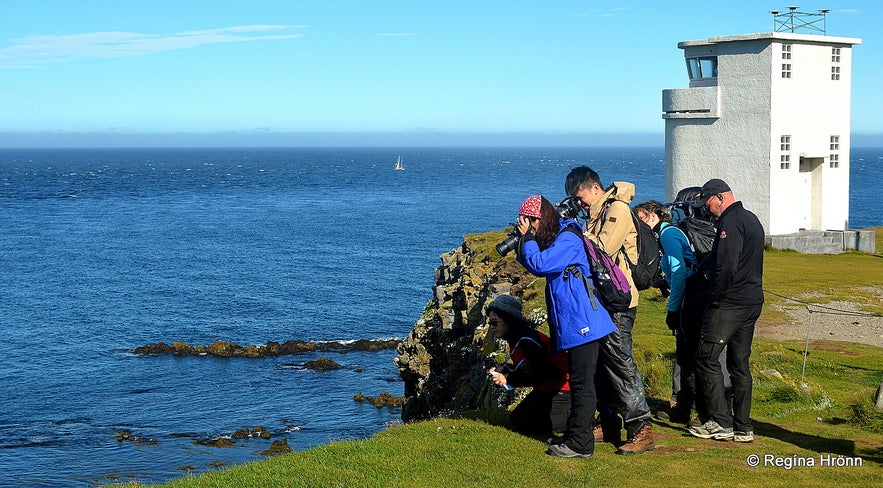
Puffin watching at Látrabjarg
Látrabjarg is sheer-sided and there is a painted white line to warn people against going too close to the edge. It should be common sense not to cross the line, but I have seen that many people don't pay any attention to the line. Be extra careful not to go too far to the edge.
The puffin burrows make the ground closest to the cliffs hollow and dangerous to step on. I lay on my stomach and looked down at the birds as to not lose balance as it is a long way down!
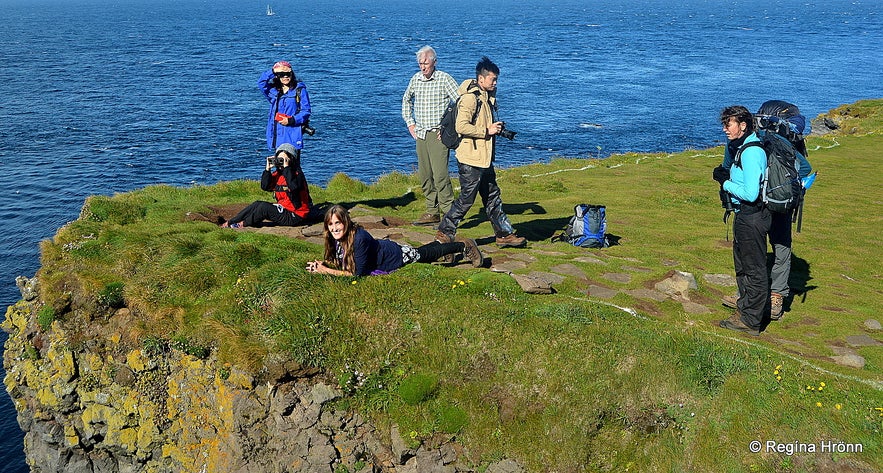
Checking out the birds at Látrabjarg
Up to 60% of the Arctic puffin colony breeds in Iceland so there is a very good chance of seeing puffins if you visit Iceland during their nesting season. The puffins stay in Iceland from mid-May until mid-August each year and all in all, there are some 8 million puffins in Iceland during the summertime!!
Unfortunately, the number of puffins is rapidly decreasing.
The largest puffin colony in the world is in Vestmannaeyjar - Westman Island, which is a volcanic island just off the south shore of Iceland. I have been there and seen a myriad of puffins, but I have never been as close to puffins as I have been at Látrabjarg, it almost feels as if one can touch them.
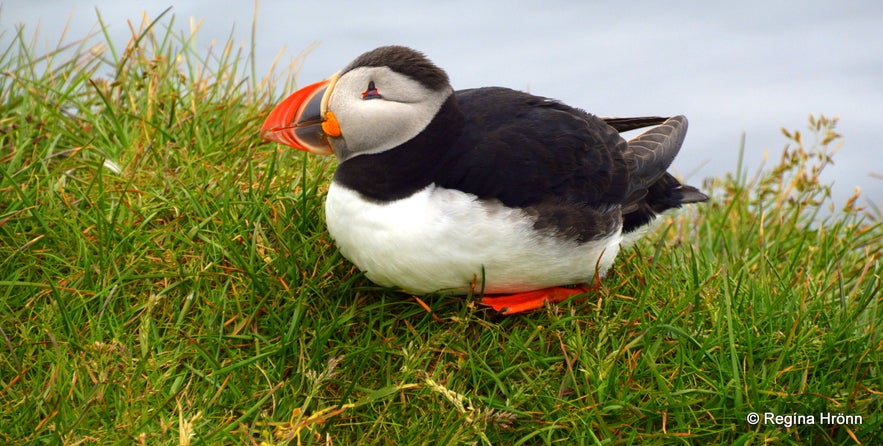
Puffins at Látrabjarg
And they are so fearless and tame somehow. It is almost as they know that we are only there to watch them and take photos and will not harm them. And it feels like they are posing for us and checking us out ;)
You can see on my first photo that the wings of the puffin are a little too small, as it were, so when it flies it flaps its wings very rapidly - it is very cute to see a puffin fly :) The puffin wings are perfect for catching fish in the ocean though.
What is characteristic of the puffins is that they dig a burrow in which they lay only one egg a year, so usually, eggs are not picked from the puffins.
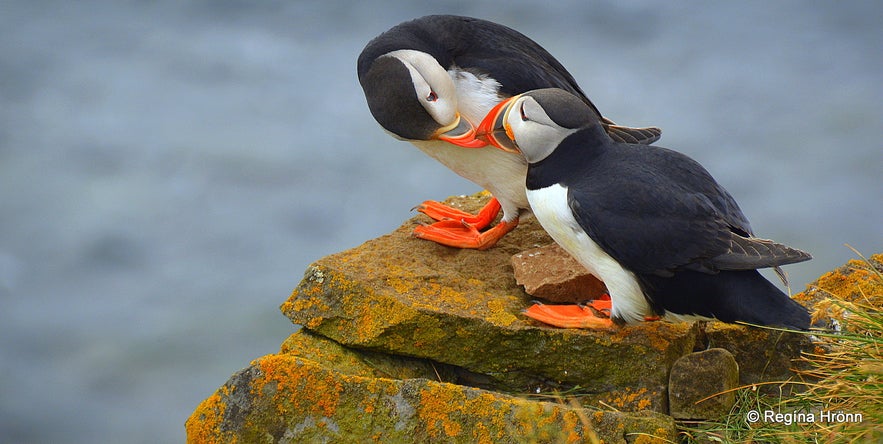
Puffins at Látrabjarg
There are some great photo opportunities at Látrabjarg, to say the least. I took so many different photos of the puffins but had to choose just a few of them to publish here. And it was hard to choose between them as you can get some extraordinary photos here.
I am in love with puffins, they are such cute birds. I have one photo of a puffin, which had ventured up on the grassy side of the cliff and was strutting along, and when the August sun shone on its black back, it looked so much like a black cat from behind. I got a sudden urge to pick it up and cuddle it, but of course, that is not allowed.
The puffins should never be touched; if you touch them they lose oil from their feathers which is essential for their survival in the sea.
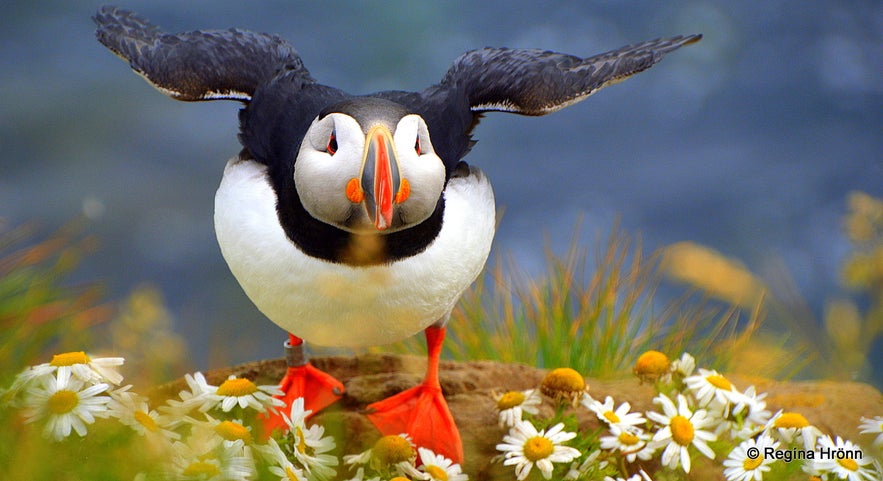
Puffins at Látrabjarg
As even though the puffins look so cute they know how to defend themselves and they have a powerful bite if they feel threatened, as the multi-Michelin Chef Gordon Ramsay found out the hard way when he tried kissing a puffin in the Westman Islands; the puffin bit his nose!
You can find the video on Youtube, but it is kind of bloody, so I didn't want to publish it in this travel-blog. You can find it in another of my travel-blogs about Látrabjarg:
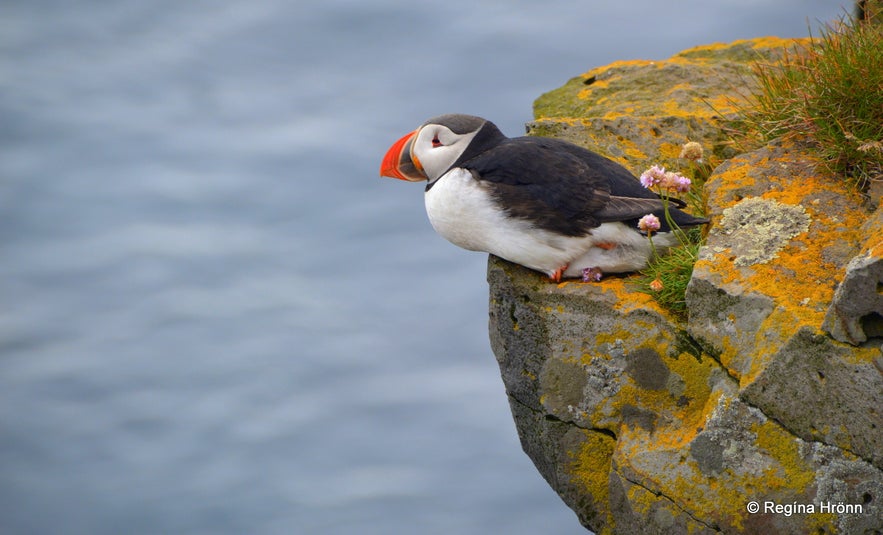
Puffins at Látrabjarg
I have seen that most visitors in Iceland want to see the puffins. You can see puffins in several places in Iceland, but Látrabjarg is my all-time favourite. In the daytime, the majority of the birds are still out at sea and in the evening they gather together in the cliffs in their thousands. We visited Látrabjarg from 10 am to 12 am and there were so many puffins on the cliffs.
The puffin which breeds in Iceland is sometimes called the "prófastur" in Icelandic, meaning the dean as it is so distinguished looking. What makes the puffin stand out is the big orange, red and grey beak and the bright orange feet.
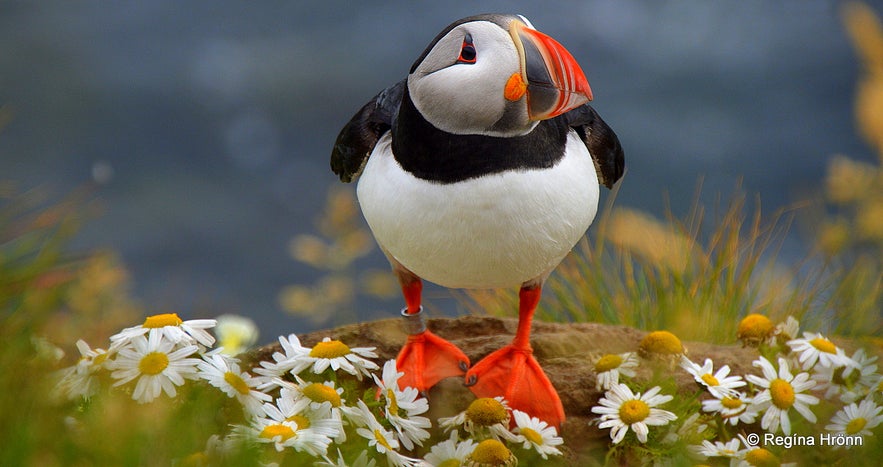
Puffins at Látrabjarg
The puffins stay in Iceland from mid-April until mid-August when they start to leave the country. In the wintertime, the puffins stay on the ocean and they don't come back until the next breeding season.
In the wintertime, the puffin loses the colour of the beak and the beak becomes grey, but I have never seen that as the birds are out at sea.

Puffins at Látrabjarg
Our whole group gathered eagerly by the cliffs to see the puffins. In Látrabjarg cliff, the puffins are so used to humans that they don't budge and either totally ignore us or take a peek at us when we are not looking. We spent a lot of time with the puffins, adoring them and photographing them.
I have seen puffins on Grímsey island in the evening when the thousands of puffins had returned from the ocean. It was, of course, awesome, but I noticed that the puffins were a bit afraid of humans, as if I went too close to the edge the whole colony on that cliff got scared and flew away - not here on Látrabjarg cliff though.
See also:
Grímsey Island Express - the Gem of the Arctic Circle in North-Iceland
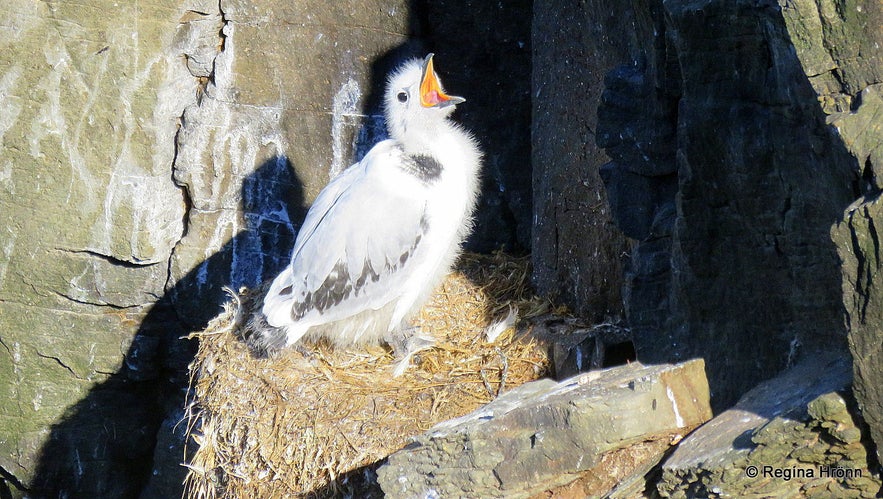
Kittiwake chick at Látrabjarg
There are of course a myriad of other sea birds on the cliffs and I saw this cute little kittiwake chick on a ledge crying out for food. Its mother doesn't carry fish in its beak to give to its chicks but pukes into its mouth. I saw the mother kittiwake hovering over the bird and left them in peace ;)
This is what the grown-up kittiwakes look like. I have never been so close to the natural habitat of birds as in Látrabjarg. What an amazing place to visit!
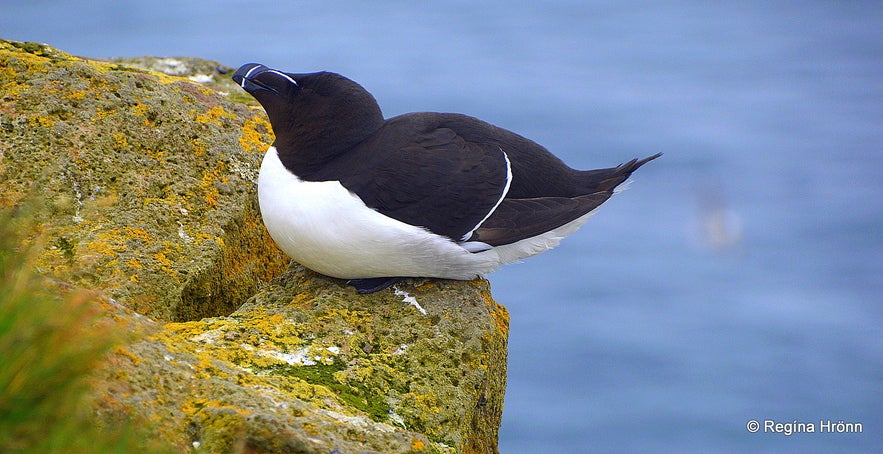
Razorbill at Látrabjarg
We also spotted some grey seals in the sea, do bring binoculars so you can see them up close, or use the zoom on your camera. They look like shining silver in the sunshine and are ever so cute :)
There are two types of seals by Iceland, the common seal, and the grey seal. The grey seal is much bigger than the common seal and can reach 2.5 meters in length and weigh over 300 kilos!
We hiked for a while on Látrabjarg and breathed in this beautiful nature filled with birds and seals. It was such a beautiful day :)
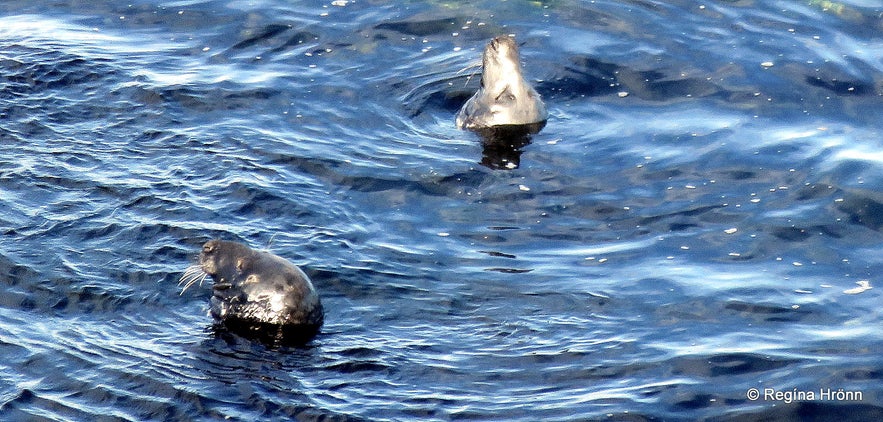
Seals in the Westfjords
After 2 hours we left Látrabjarg and drove for 12 km until we reached Breiðavík cove, where there is a hotel and a beautiful pink beach.
See also:
We walked down to the beach and just enjoyed being outside in the fresh air on this warm sunny August day. Iceland's beaches are usually black lava beaches, so I am not used to a pink beach like they are used to up in the Westfjords.
So I was thoroughly enjoying this tour and strutted along this beautiful pink beach very happy and felt like I was abroad.

Breiðavík beach
I felt like I was on a beach in Spain and wanted to jump into the sea. The Atlantic ocean is too cold to swim in, so I didn't do it though.
Our fellow passengers were from Hong Kong and they asked if we could stay on this beach all day long as the air was so fresh and clean :) We Icelanders are used to having clean air here in Iceland and don't think about it much, but hearing this gave me a different perspective on what we Icelanders take for granted. One has got to love clean fresh air and appreciate it!
We had a museum to go to and after that the vast red beach, Rauðasandur, which is unique in Iceland, so we had to carry on.
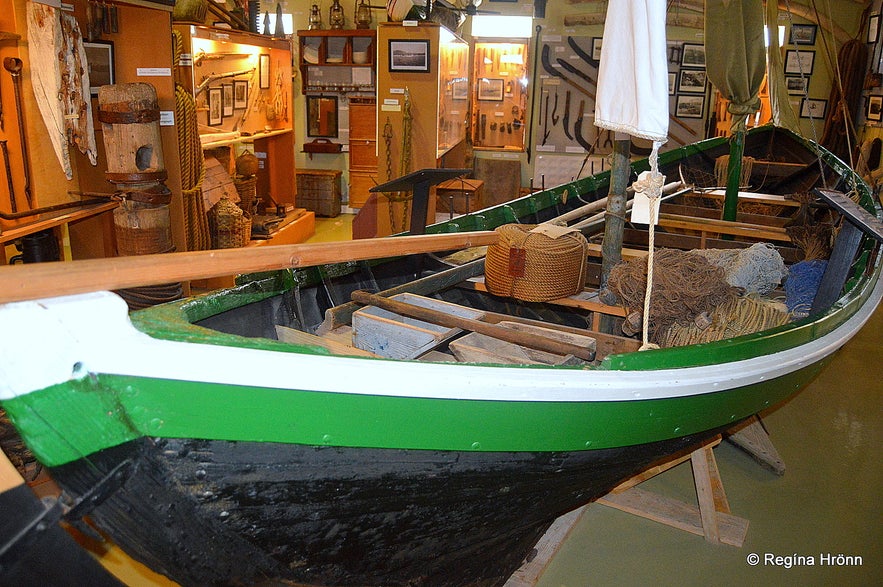
Hnjótur museum
Our next stop was at the museum Hnjótur by Örlygshöfn. This museum depicts the history of fishing, farming, and daily life in the southern part of the Westfjords through the ages.
The museum was founded in 1983 when Egill Ólafsson and his wife donated their museum to the county. Egill was an avid collector of things from the past and got rewarded the Order of the Falcon for saving cultural values from being lost. Kudos to such forward-thinking people!
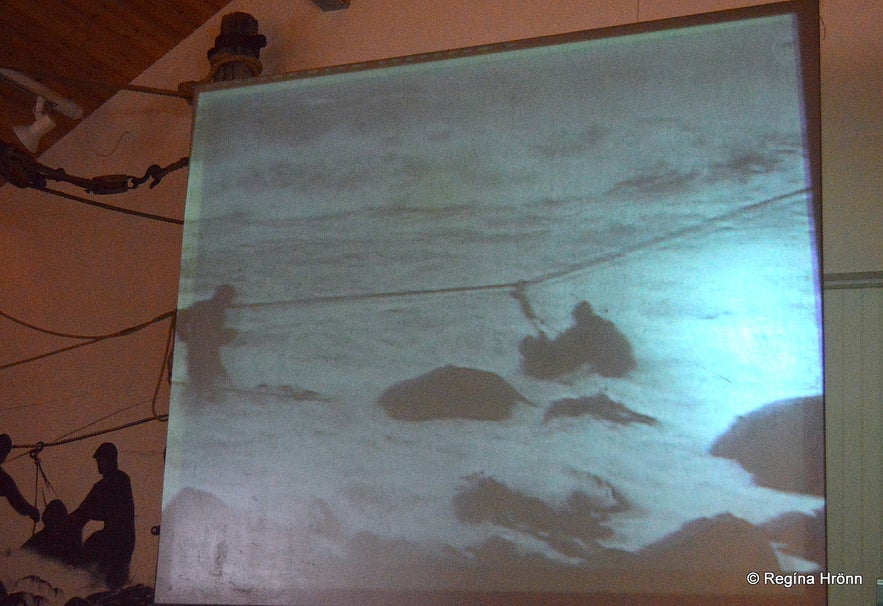
Hnjótur museum
On the 12th of December 1947 the British trawler, Dhoon, stranded by Látrabjarg sea-cliffs in fog and heavy undercurrent. There were 15 people aboard the trawler, 12 of which were saved under very difficult circumstances by the local volunteer rescue teams and the local farmers. The farmers heaved the men up on a string to safety in cold and bad weather. These farmers used such a string to hang from the cliff while collecting bird eggs.
A documentary was made on this rescue operation a year later, where the men re-enacted their rescue operation. The first half of the film had been shot and the second half was being shot at Látrabjarg when the trawler Sargon stranded at Hafnarmúli by Örlygshöfn.
The men had to hurry up to rescue the Sargon and the director of the documentary filmed the rescue operation of the trawler Sargon using that footage in his documentary on the British trawler Dhoon.
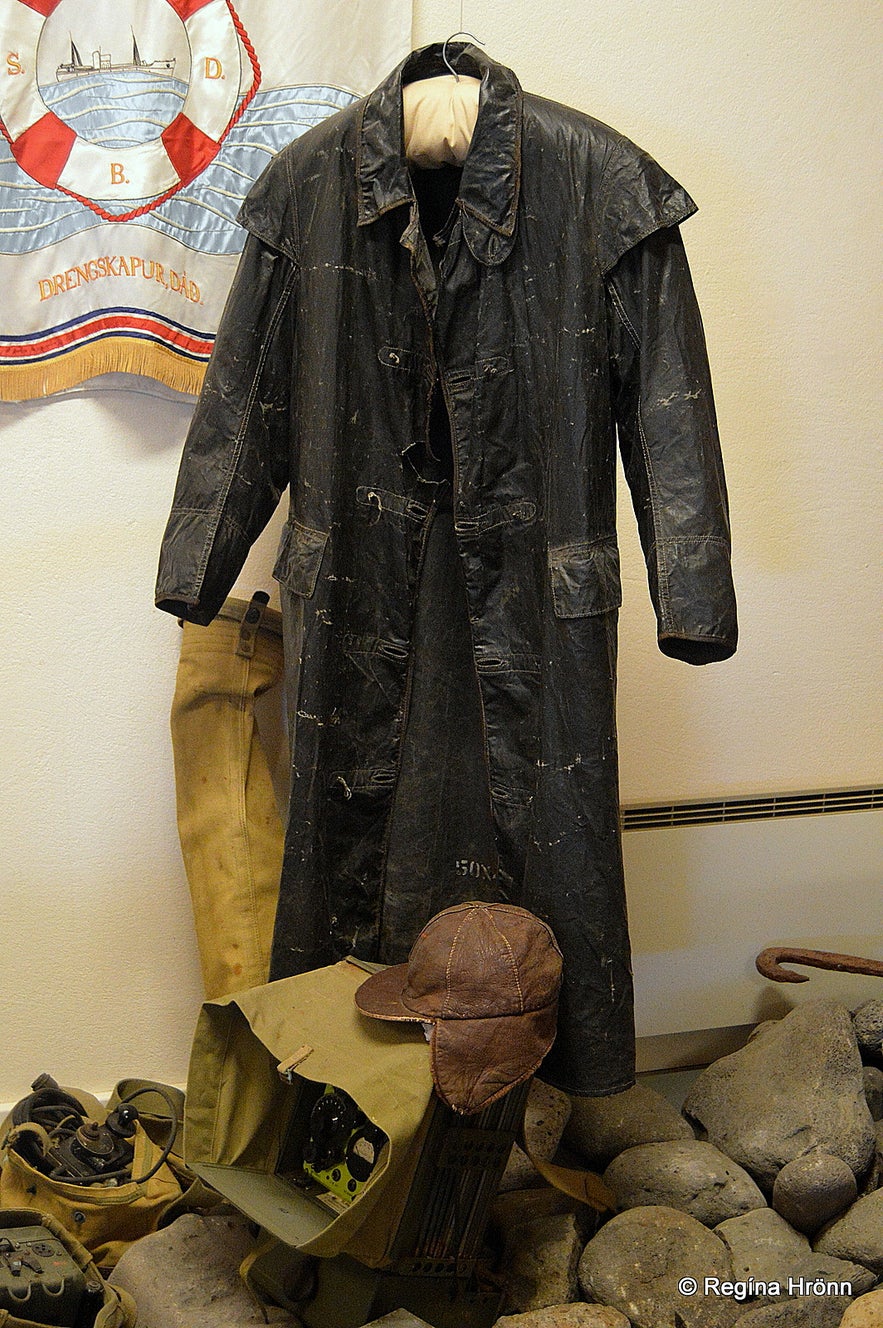
Hnjótur museum
We watched half the documentary at Hnjótur museum and I was reduced to tears when watching this film, what hardship and what charity.
What resilience of these Icelandic men not giving up until they had rescued most of the English seamen from a sure death here on the biggest bird cliff in Europe in the dead of winter! What an extraordinary achievement!
There is a monument at Hnjótur, in honour of the Icelandic rescue workers, to commemorate their achievements in rescuing local and foreign fishermen from the dangers of the sea. And in remembrance of those who couldn't be saved.
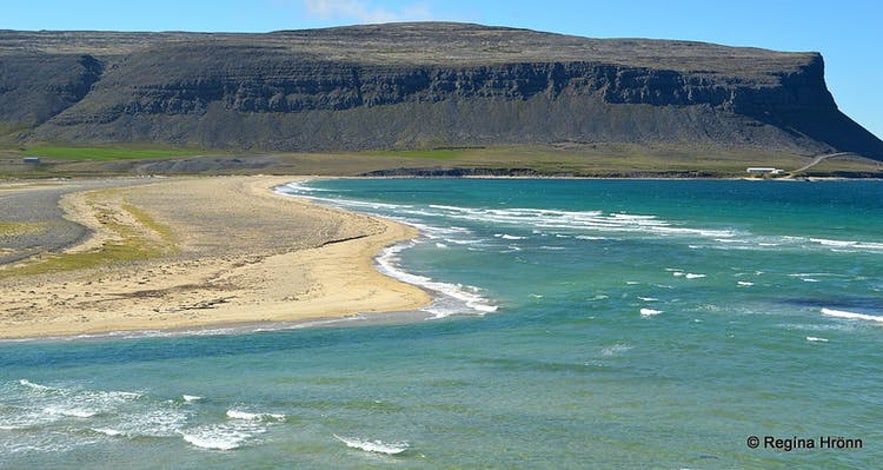
Örlygshöfn in the Westfjords
Several other shipwrecks have happened in this area. In the winter of 1918 (a winter which was one of the coldest winters in Iceland), an unknown trawler sank by Örlygshöfn. The weather was calm, but there was heavy snow with zero visibility.
The farmers at Örlygshöfn heard a steamship whistle, but couldn't see anything. In the spring a shipwreck was found by Látrabjarg bird cliff. It was unidentifiable and nothing has ever been found out about this ship, not even its nationality. What a tragedy :(
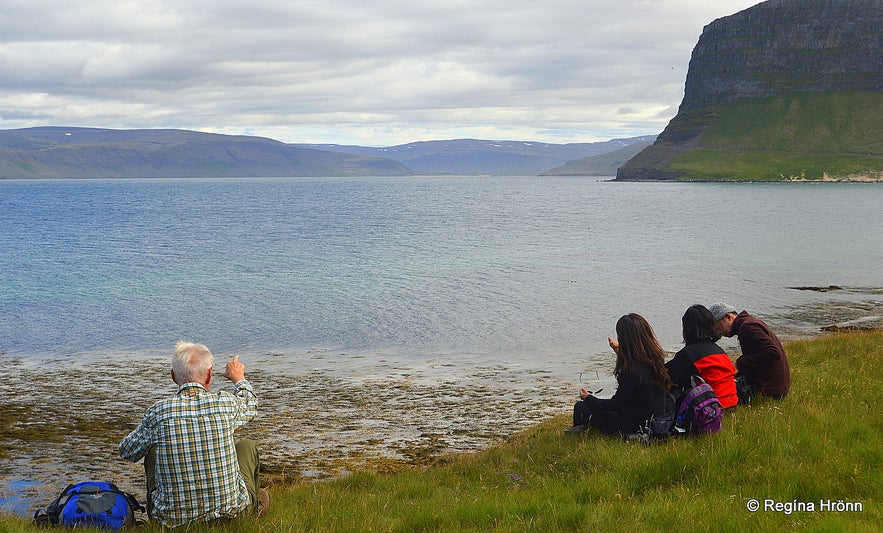
Picnic at Örlygshöfn in the Westfjords
We had had some coffee at the museum, but by now it was time to have a picnic. We sat down by the sea by Gjögrar harbour in Örlygshöfn and enjoyed the views of Patreksfjörður fjord. In the distance, we could see Patreksfjörður village.
Our travel companions had only bought the Látrabarg part of our guided tour so after the picnic we left them at their hotel, which was in the vicinity. Our next destination was the extraordinary Rauðasandur beach.
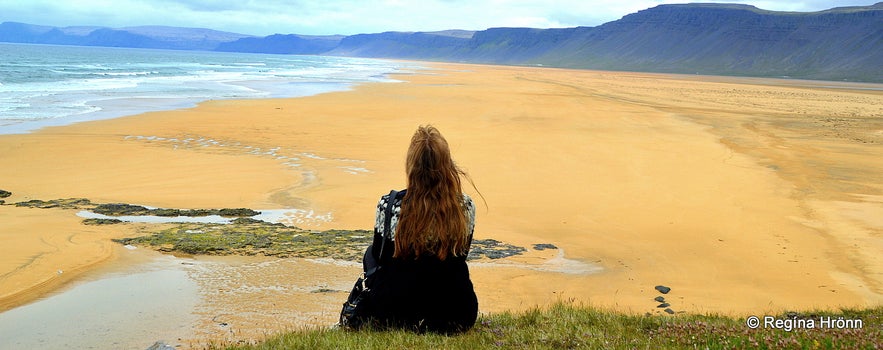
At Rauðasandur
Rauðasandur (or Rauðisandur) Red Sands is one of Iceland's most beautiful beaches. It is a beautiful orange/red beach, which stretches for 10 km from Látrabjarg bird-cliff in the west towards Skorarhlíðar mountainside in the east.
Rauðasandur orange-reddish colour stems from pulverized scallop shells from the Breiðafjörður bay. The name can also derive from the settler in this area, Ármóður rauði Þorbjarnarson or Ármóður the Red.
It is such a beautiful place and I couldn't get enough of it - I felt like I had stepped into a fairytale world :)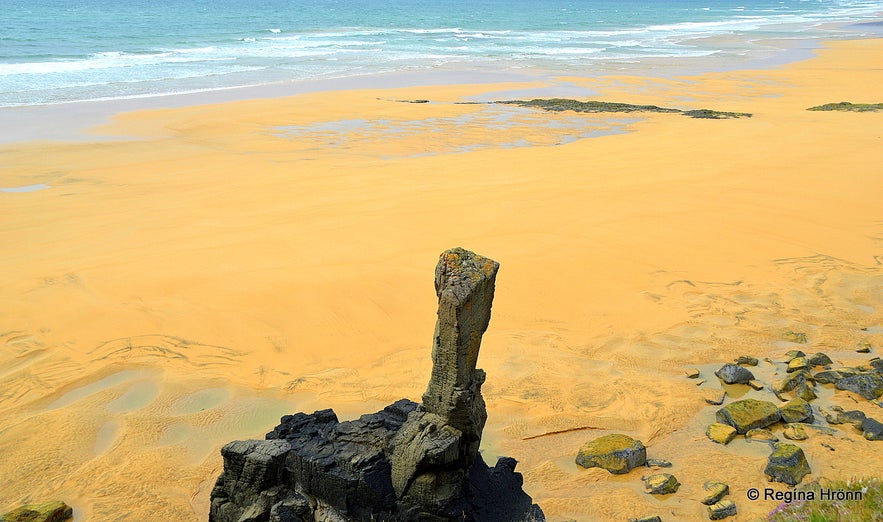
Rauðasandur
It is just lovely being here in the tranquillity and beautiful pristine nature. The road leading to Rauðasandur is a winding and steep road though, so I was happy to be driven here by an experienced driver and a guide.
I have been to Rauðasandur before on the western part where we had to walk on water, as it were, to reach the red sand.
This time we visited the eastern part of Rauðasandur, where it was easy walking down to this beautiful beach.
See also:
Rauðasandur Beach & Sjöundá in the Westfjords of Iceland - Red Sands & a Crime Scene
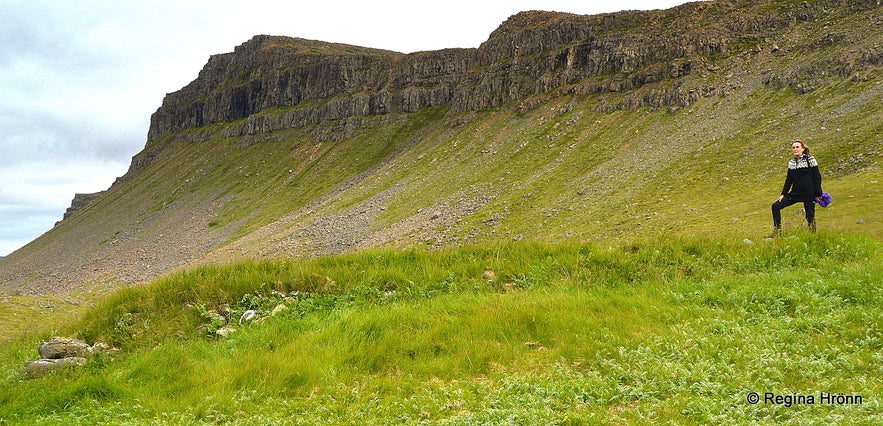
The ruins of the old turf farm by Sjöundá which I visited the following year
On this side of Rauðasandur, a crime story took place. By the farm Sjöundá around 1800, there lived two married couples. Bjarni and Steinunn, the husband from one marriage, and Steinunn, the wife from the other marriage, had an affair.
They ended up murdering their spouses. They were placed under arrest and trialed for the murders, found guilty, and sentenced to death. Bjarni was executed in 1805 in Norway but Steinunn died in prison in Reykjavík.
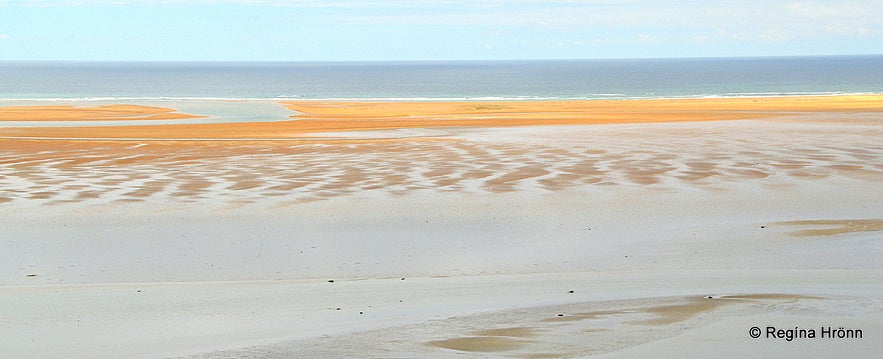
Beautiful Rauðasandur
You can see many grey seals at Rauðasandur and in the summertime, there can be up to 100 seals resting and sunbathing in this area. I know that Westfjord Adventures offers a special tour to the seal colony at Rauðasandur as our driver told us so, and next time I visit the Westfjords I would love to join that tour.
There are so many tours I want to join in the Westfjords that I will have to camp somewhere for a week and go on tours every day.

With Úlfar and Gunnar, the guides of the tour
After spending some time at Rauðasandur it was time to head back. By the time we reached the junction of Látrabjarg, where we had left our car, it was already 5 pm. Time had flown by on this fun tour.
I said goodbye to Úlfar, our expert guide, and Gunnar, the driver, whom I was later to meet at the Jewel of the Westfjords, Dynjandi waterfall.
This guided tour from Westfjord Adventures is operated from May-August from Patreksfjörður village.
Have a lovely time in the Westfjords :)
其他有意思的博客
冰岛最浪漫的角落
对于很多人,遥远的冰岛有着世界尽头的神秘,有着区别于巴黎、马尔代夫、自成一体的浪漫。没有埃菲尔铁塔和蒂凡尼,没有热带沙滩,而是在冰川、火山、苔藓地的背景下蜜月旅拍、婚拍,甚至举办一场冰岛婚礼。来冰岛旅行,多是要跨千山万水、飞跃大洋大陆,很有一点“万水千山陪你走过”的史诗感。难怪很多人说,光是冰岛二字,就足够浪漫了。 冰岛虽然不大,但是地貌极其丰富,不同的自然景观自然有不同的气质。这一篇,就挑阅读更多从极光观测到摄影-到底该不该来冰岛看极光
很多朋友都想来冰岛看极光,但是冰岛到底适不适合看极光呢?几月、什么季节能看到极光?是不是一定要参加北极光旅行团?如何能拍摄出美丽的极光照片呢?在冰岛住了好几年了,从刚开始逢极光必出门,到如今家里阳台就能看极光,我对在冰岛看极光的了解和经验,也算得上大半个专家了,且听我娓娓道来吧。 到底该不该来冰岛看极光呢?最坦诚的答案是,不要只为了看极光而看极光。 极光原理 太阳活动→太阅读更多
迷失冰岛的米湖游览推荐|不只有温泉的地热宝藏区
我在冬夏秋均到访过米湖,看过米湖的不同面。一直以来,米湖到底值不值得去是很多游客争论的问题。有些人觉得这里是来冰岛旅行的必去目的地,有些人则说米湖“太丑了”,连照片都不想多拍几张。那米湖到底值不值得来呢?到底怎么玩呢? 米湖的风景 北部的米湖,因地理位置相距首都雷克雅未克略远,很多来冰岛的短途游客选择放弃,其实米湖应该是和黄金圈、南岸沿线至冰湖齐名的冰岛景色,这里冷热相融,可谓最冰岛,尤其阅读更多

将冰岛最大的旅行平台下载到您的手机中,一站式管理您的整个行程
使用手机摄像头扫描此二维码,然后点击显示的链接,将冰岛最大的旅行平台添加到您的手机中。输入您的电话号码或电子邮件地址,以接收包含下载链接的短信或电子邮件。

















